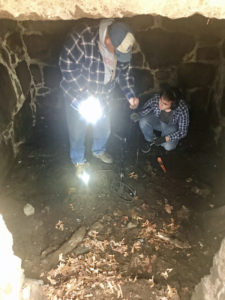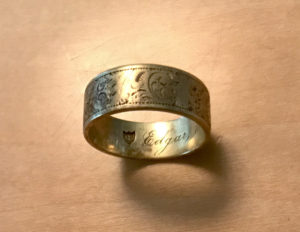True Tales from Canton’s Past: Lost and Found
By George T. ComeauThere is always talk of passing the torch to a new generation. And at the venerable local Historical Society very few young people become engaged in the work of preservation and discovery. Yet every once in a while a young person will enter our orbit, and through their eyes we see the history of Canton anew.
At an event last year there was a talk at the Canton Public Library and that is when we met Paul Buckley Jr. The affable young man was home for the weekend from college and brought a small bag of artifacts to the lecture. It turns out that Buckley is an amateur historian. At a very young age he had dug his way into a crawlspace under the early 19th century home that once was owned by Captain James Endicott. Inside the space, no more than perhaps four feet tall, Buckley used a metal detector and began digging up artifacts.
The Endicott House on Washington Street is the first brick house in Canton. After a fire destroyed the original house, Paul Revere and the rest of the community pledged money and materials to rebuild the house for Endicott — a hero of the American Revolution. The items that Buckley was digging up dated to the time of the rebuilding of the house in the early 1800s. The items, taken as a whole, are a window into the past and the Buckley family has a beautiful cabinet that bursts at the seams with the items found on the property: old buckles, bits of china, casings from bullets, and lots of oddities. As far as metal detecting goes, there is an art and science to the process and Buckley knows his work well.
Recently, Buckley attended the unveiling of the Crane’s Guard Flag as part of the annual meeting of the Canton Historical Society. Again, he arrived with a small handful of artifacts — a pair of mid 19th century sleigh bells with ornate designs that were dug up from behind the spot where the Endicott barn once stood. It was then and there that Jim Roache and myself decided we would press Buckley into service with his metal detector.
On an overcast day in April, a small group of local historians arrived at the Canton Corner Cemetery. The stone receiving tombs have recently been repointed as part of a Community Preservation project. There are three small family vaults and one large public receiving tomb that were used to hold deceased bodies through the winter, and when the ground thawed, they would be placed in graves within the cemetery. There are no remains in these historic structures and over the years they held gravestones that had been damaged or broken. The tombs date to 1837 and were part of a plan to sell these to wealthy families. The plan never took off, and they were only used as actual tombs for a short period of time. It is important to stress that here are no remains in any of the tombs today.
The goal for the work inside the vault and tombs was to clean out the debris that has accumulated inside over the last 100 years or so. In at least two cases, the iron doors had been sealed for over a century. Opening the first vault, the historians saw that dirt had accumulated where the stairs descended down approximately six feet underground. The dirt was carefully shoveled into buckets and screened for any artifacts. Meanwhile, Buckley and Sepp Bergschneider of the Historical Commission began scanning the floor with a metal detector.
Within moments the ping of the metal detector indicated a “hit.” As Buckley knelt into the wet soil, he carefully pulled back a few inches of dirt. A small 18-karat gold ring was found and the historians buzzed with excitement. We had found a wedding band and there was a clue to whose it was — inside the ring was engraved “Edgar to Clemie.” That one clue would not be enough to discover the whole story. As work continued, dozens of small brass studs and stars were recovered. The theory was that these items were part of a coffin that may have been stored there at one time. Small hasps for locks and tiny hinges were found. There was a lot of metal inside the dirt floor. Meanwhile, as the dirt was cleared from the steps, a large stone tablet was revealed. Hauling the tablet out into the sun revealed the name “Isaac Horton.”
Two major clues were unearthed — the engraving inside the ring and the name Isaac Horton. Within minutes, Jim Roache returned from the Historical Society and confirmed that this empty vault was once the tomb of Isaac Horton, a wealthy man that had once been the quartermaster for the local militia. Horton was born in 1784 and died at age 58 and was placed in the tomb in 1842.
The ring was indeed connected to Isaac Horton. It turns out that Isaac had a son — also named Isaac and he died in September 1878. Isaac Jr. was buried in an expanded portion of the cemetery and it is believed that on that date in 1878 the body of his own father was moved from the tomb to be buried alongside. The ring was likely dropped from the pocket of Edgar Horton when he assisted with the removal of his great-grandfather’s remains to a new grave to be with Edgar’s grandfather. The ring was found 141 years later.
Now, a few connections had to be made. William Edgar Horton (known as Edgar) was born here in Canton in 1844 and his father was a bootmaker and large landowner. It was Edgar’s father who, in 1846, sold 10 acres of land that is now in the Canton Corner Cemetery and where the current Horton family plot now stands. Edgar was very bright, and family money meant that he could attend private schools in both Foxborough and Sharon to prepare him for college. Edgar attended Amherst College and graduated in 1867. By 1869, he was the principal of the high school in Foxborough.
In October 1870, Edgar married Clemie, a schoolteacher from Stoughton. They loved each other dearly and the wedding band he slipped upon her finger would remain there until death parted them from each other on March 9, 1878. The couple had at least two sons and lived comfortably and happily together for eight short years. Clemie died of what was then called “lung fever” and what we now know as tuberculosis. Edgar buried his wife in a family grave at the Rockhill Cemetery in Foxborough.
It was a sad time for Edgar, and he carried that wedding ring everywhere he went in memory of his beautiful wife. Seven months after Clemie’s death, Edgar lost the ring when helping to remove the remains of his great-grandfather. The ring dropped to the soft dirt floor and went unnoticed until Paul Buckley discovered it last month. The story builds on historical fact and a small degree of logical supposition. How else would a wedding ring be found in the empty tomb of a great-grandfather who died long ago? It all makes sense, and the best part of the story is that Edgar Horton would have loved every facet of the discovery. Edgar died in 1912 — and had been the president of the Foxborough Historical Society at the turn of the century. As someone remarked on the day we discovered the ring, “It wanted to be found.”
Short URL: https://www.thecantoncitizen.com/?p=55500












